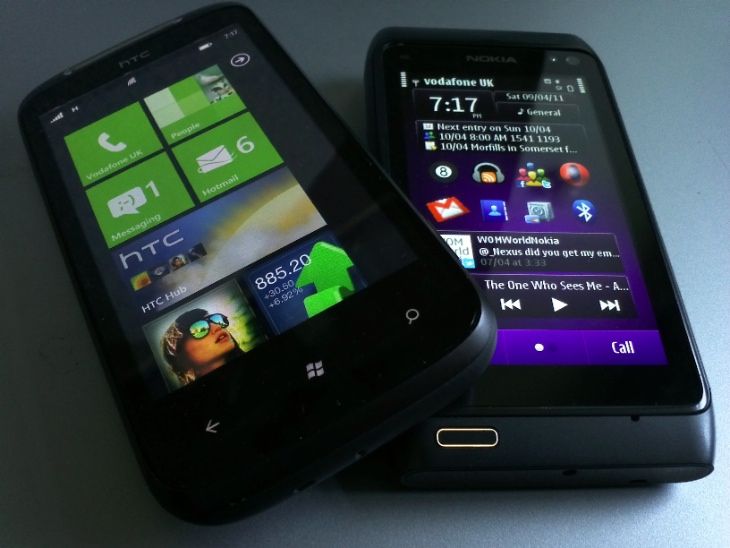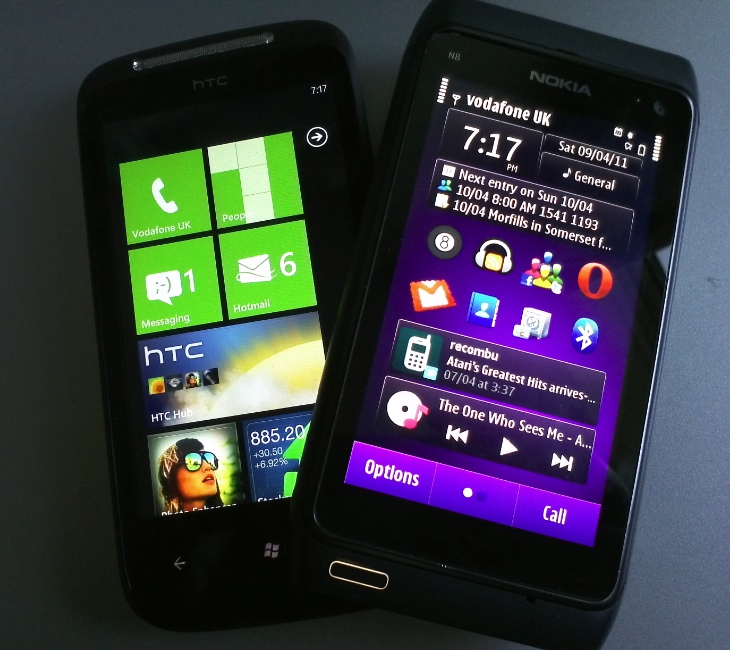
With almost identical form factors and ambitions, the Nokia N8 and HTC 7 Mozart make, in theory, for a super head to head comparison. The latter device has received a slightly limited release, not least because Orange snapped up the rights, in the UK at least. But I've now had the chance to put it through its paces.
As usual, I've tinted with green the cells in each row that indicate an obvious 'winner' for that attribute, for interest sake, and if appropriate. See below for both comment and some illustrated photo and video samples.
| Nokia N8 | HTC 7 Mozart | |
| Latest firmware | v14 (PR 1.2, PR 2.0 expected imminently) | Windows Phone 7 |
| Form factor, materials | Aluminium shell, plastic end caps, full-face glass capacitive touchscreen, 135g | Mix of rubberised plastic and aluminium, full-face glass capacitive touchscreen, 130g |
| Dimensions | 113.5 x 59.1 x 12.9 mm | 119 x 60.2 x 11.9 mm |
| Connectivity | Pentaband 3G, Wi-Fi b/g/n, Bluetooth 3.0, 'USB on the go' (to USB disks/accessories) | Dual band 3G (according to market), Wi-Fi b/g/n, Bluetooth 2.1 |
| Input mechanisms | Virtual qwerty landscape keyboard with writing aids, plus virtual numeric 'T9' input in portrait mode. Compatible with most Bluetooth and USB keyboards | Virtual qwerty keyboard in both portrait and landscape modes (where appropriate), with writing aids. |
| Display | 3.5" (360 x 640 pixels) AMOLED with anti-reflection layer, gorgeous indoors, still readable in bright sunlight | 3.7" (480 x 800 pixels) Super-LCD, great indoors at full brightness but very hard to read outdoors in bright sunlight |
| Interface | Symbian^3, kinetic scrolling everywhere, multi-touch where needed, three homescreens of live widgets, whole interface works in portrait or landscape mode. | Windows Phone 7, flexible homescreen launcher system but little live information; multi-touch where needed, portrait mode enforced most of the time. |
| Speed | Good, with 130MB free RAM and a Broadcom graphics processor to help out with effects, transitions and multimedia. Video playback is terrific, with a wide range of codecs supported |
Built-in applications are speedy but, crucially, there's no multitasking of third party applications, so each has to start loading from scratch after every single interruption. For the power user, this leads to a very frustrating and disjointed experience. Video playback is good, but is crippled by all videos having to be sanitised (re-sampled) by Zune Desktop, a process which can take hours. |
| Memory capacity (storage) | 250MB of (C:) system disk, plus 16GB mass memory and microSD expansion. Apps can be installed on any disk. Plugging in the phone to any desktop computer allows mass memory and microSD to be mounted and treated like any other disk. | 8GB internal disk, no expansion. In practice, this is a big limitation, considering the media pretensions of the device. There's no disk mounting support, all transfers have to go via Zune Desktop and its proprietary protocols. |
| Camera (stills), daytime | Superlative 12 megapixel stills, taken very quickly, with huge sensor and professional optics. Exposed camera glass. See the detailed comparison below this table. | Barely acceptable (heavily sharpened) 8 megapixel daytime stills only if you know what you're doing and if you work around the shutter lag with posed subjects and awareness of light and motion. In low light, the tiny optics and sensor struggle hugely. Exposed, though fairly recessed camera glass. See the detailed comparison below this table. |
| Camera (stills), night-time | Super Xenon flash and tuned camera hardware make for foolproof evening/social shots. See the detailed comparison below this table. | Appalling Xenon flash-lit photos. Scandalously bad. It seems the shutter speed and flash aren't tuned very well, since there's blurring here as bad as anything that you'd get with an LED flash. Sadly. See the detailed comparison below this table. |
| Camera (video) | HD (1280 by 720) video is superb, fixed focus but very large depth of field, from 50cm to infinity, plus intelligent (non-lossy) 3x digital zoom; audio capture in stereo and with pro-quality digital mikes. See the detailed comparison below this table. | HD (1280 by 720) video is pretty good, considering the limited HTC plastic optics, and with (very nice) continuous auto-focus. Audio capture is in mono and acceptable. See the detailed comparison below this table. |
| GPS and navigation | Good GPS, backed up by Nokia Wi-fi location, with Ovi Maps 3.4 worldwide free sat-nav. Maps can be pre-loaded by continent, country or area. Includes digital compass. | GPS and wi-fi location, with Bing Maps providing basic mapping but not real time navigation. Everything is loaded over the air. |
| Audio out | Loud mono speaker, 3.5mm jack, A2DP, FM transmitter to car radio, plus Dolby Digital Surround Sound (through HDMI port) | Quiet mono speaker, suspect limited by the OS itself to avoid distortion of the cheapish component. 3.5mm jack, plus A2DP |
| Web browsing | Symbian Web (webkit-based), functional without ever really impressing, though there is Flash support (including video) if needed and multi-touch | Browser is fast and fluid, though with only partial Flash support, so few embedded videos work. There's multi-touch and also some intelligent reflowing of text blocks after double-tapping to zoom in |
| All purpose Mail client provides 'push' facilities for Mail for Exchange, Hotmail, Gmail, Yahoo! mail and many others - works well on the whole but some limitations and annoyances | Tightly integrated Hotmail client, plus a general purpose POP3/IMAP/Exchange client, mailboxes appear as their own 'applications' in the main pick list | |
| Other application highlights out of the box | Quickoffice viewers, Dictionary, Zip manager, Photo editor, Video editor, Web TV, Nokia Social Networking (needs the 1.3 update to be usable though) | Pocket Office, including OneNote, Word, Excel and (in read only form) Powerpoint, Facebook integration throughout, Photo Enhancer, Stocks, Xbox Live integration and games |
| Application store and ecosystem | Ovi Store client v2.0, hundreds of native Symbian applications are compatible. There's currently no automatic update system and apps are expected to go online and check for themselves if updates exist | Windows Marketplace is now pretty well stocked and the built-in search problems are fixed with the latest Windows Phone 'No-do' update. Application updates need to be manually checked and applied, but at least are applied all in one go. |
| Battery | 1200mAh, not strictly user replaceable (though it's not that hard, can be done in under 1 minute), microUSB or 2mm charging, nightly charging needed for power users | 1300mAh, battery can be swapped, microUSB charging, nightly charging needed for power users |
| Ongoing firmware support and OS updates | Prospects good, Nokia has already committed to two major PR firmware updates in the next six months, most experts estimate support and upgrades will continue for up to 18 months. Many OS modules and components can be upgraded as-and-when using the 'Sw update tool' in the device | The recent 'No-do' update added copy and paste to the text editing side of things. Microsoft promise an update to add multitasking of third party applications before the end of 2011 |
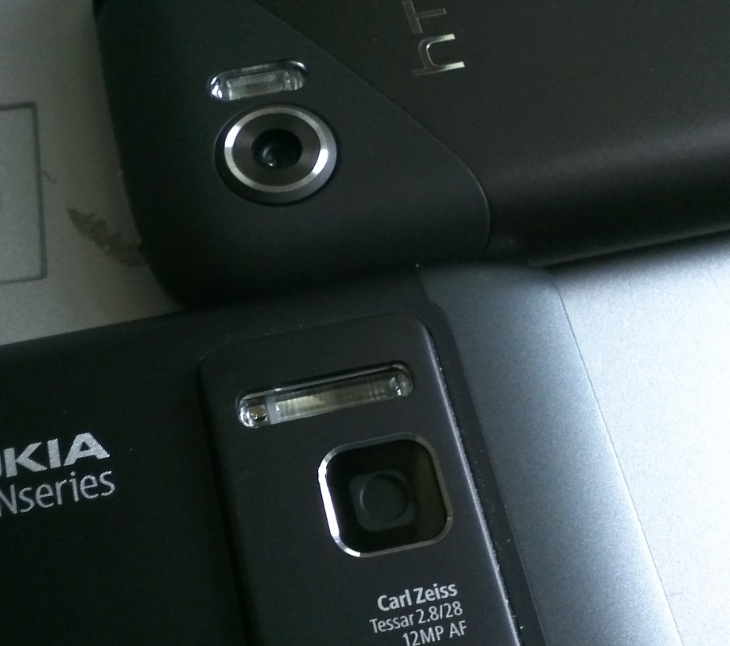
Of course, the big USP of the HTC 7 Mozart is that it has a higher specification camera than your standard HTC fare (which isn't saying a lot). There's a slightly larger camera surround, to protect the camera glass, but it doesn't seem as if the optics and sensor are much larger than usual. Alongside the lens is a tiny Xenon flash - and I mean tiny. The Nokia N8's Xenon is fairly weak (compared to early smartphones like the N82), but the N8's flash is many times bigger and brighter than the 7 Mozart's.
All of which is borne out in the photos taken by the two devices.
Test 1: Bright sunlight

Here's the scene. Bright sun, colourful flowers, what could go wrong? Let's snap it and then crop into the central fragment, Nokia N8 on the left (obviously) and HTC 7 Mozart on the right:
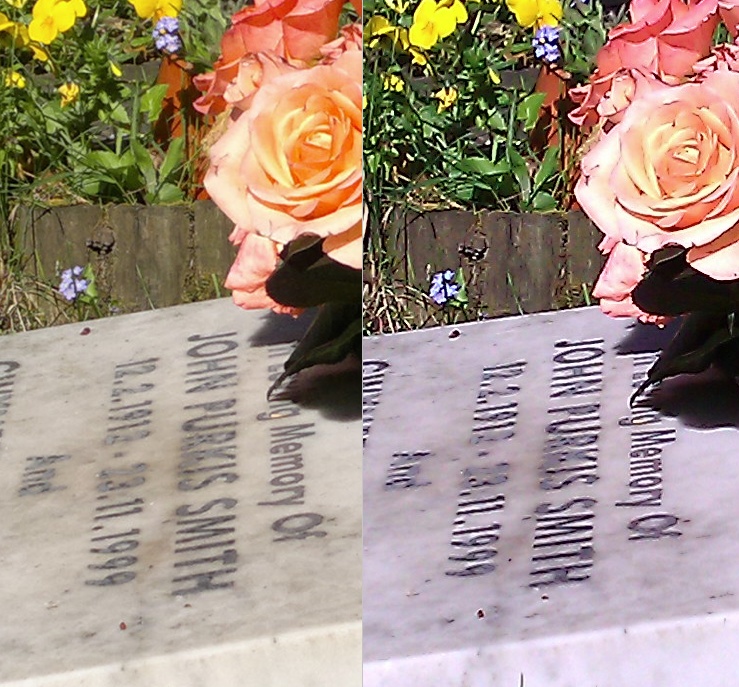
It's worth saying that the HTC 7 Mozart's photo loooked fine on the phone screen - at least indoors, later on - you can't see the screen when actually out IN the sun. But it's painfully obvious that there a big gulf between the two devices' output. The 7 Mozart's photo is dramatically over-sharpened, colours aren't as natural and very bright details are 'blown out'.
Test 2: Low light
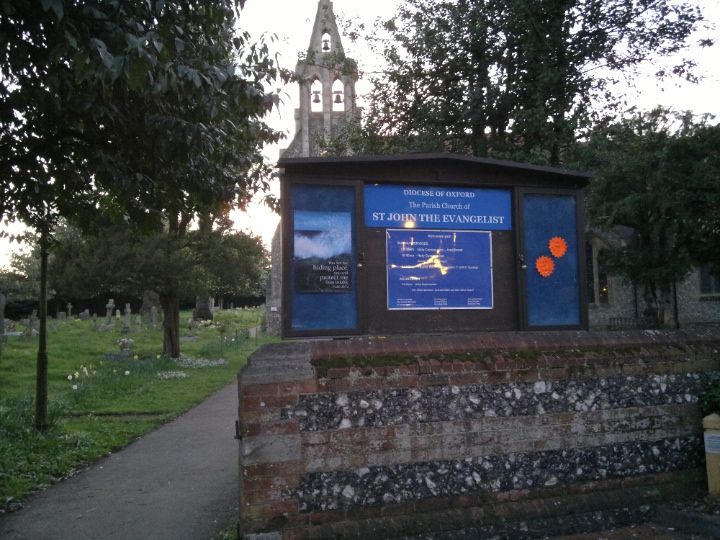
Here's the scene. The sun was setting, light was low. This sort of shot is a great test of how good a camera phone's sensor and optics are, since every photon, every sensor cell counts.
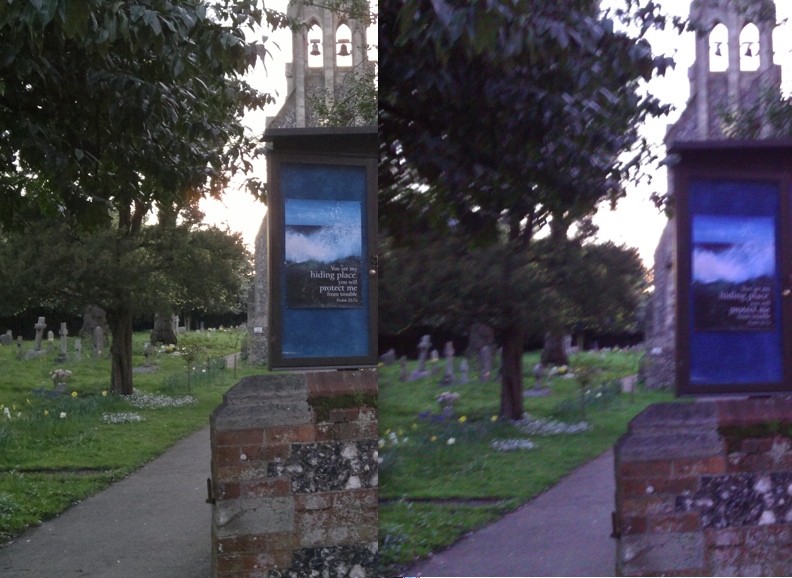
Again, there's no contest - the N8's huge sensor and professional optics bring out detail and clarity, even with very little natural light available. From the flowers to the writing on the poster to the bells in the bell tower, the 7 Mozart's photo is simply horrible. It seems that the shutter speed has to be increased so much in order to let in enough light, through the small optics, that even a steady-ish hand like mine isn't enough to prevent a blurry mess.
Test 3: Xenon-lit evening shot
The set up here was me pretending to be a trendy young thing dancing at a night-club (yeah, right!), so moving naturally while the Xenon-powered camera phones 'froze' me in time using their ultra-brief, ultra-bright flashes. Well, that's the theory anyway.

As you can see from the comparison above, even calling the HTC 7 Mozart's Xenon flash 'appalling' doesn't really do the truth justice. In truth, the Xenon might as well not exist - the results are identical with those from a camera phone with LED flash: moving people become blurry messes. In contrast, Xenon the N8 does what it's supposed to do and freezes the moment in time - more or less perfectly.
And in case you are thinking that I picked a bad example from the 7 Mozart - I actually tried four times and this is the BEST one of the four. I simply couldn't believe the Xenon flash was this bad. Methinks HTC are short changing customers on component quality, not for the first time.
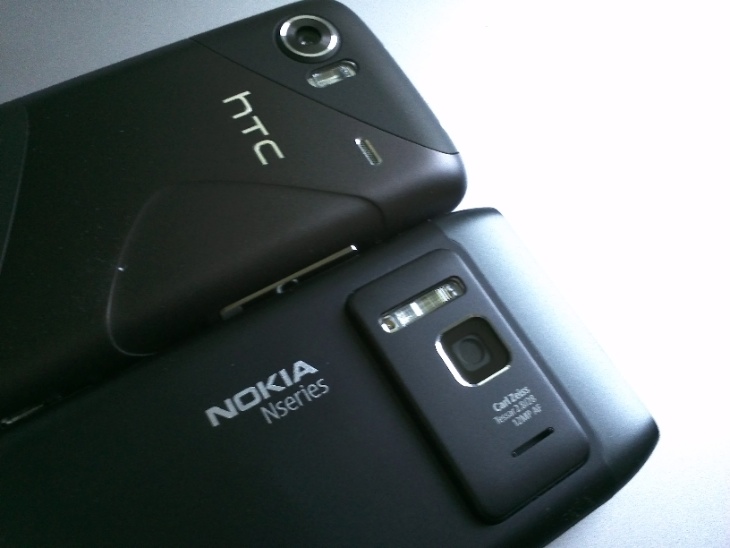
And so we come the verdict. The HTC 7 Mozart does indeed have a 'modern' (as in, invented recently) OS and a super-fluid (future proof?) interface, but it struggles to best the Nokia N8 in many areas, mainly (though not entirely) due to hardware specification and component quality. In the crucial camera department, the N8 leaves it trailing miserably behind - and remember that this device has the BEST camera of the current Windows Phone 7 pack of devices.
The interesting question, looking to the future, of course, is: "Would I be happy with the Nokia N8 hardware and the HTC 7 Mozart software?" Not really, the latter is still too immature - the lack of app multitasking alone is a showstopper for anyone used to Symbian and Android. But I can see potential, I did (some of the time) really enjoy the updated Windows Phone 7 interface, and, like most observers of the industry, I can't wait to see what Nokia do with Windows Phone (8?) in 2012, bringing Nokia build quality and components to a scene that's currently being rather crippled by shoddy HTC hardware.
PS. You will be able to see more of my opinions of the HTC 7 Mozart in Phones Show 137, out in the near future.
